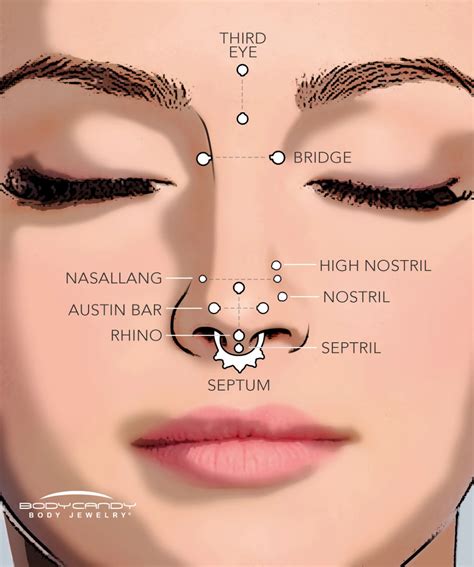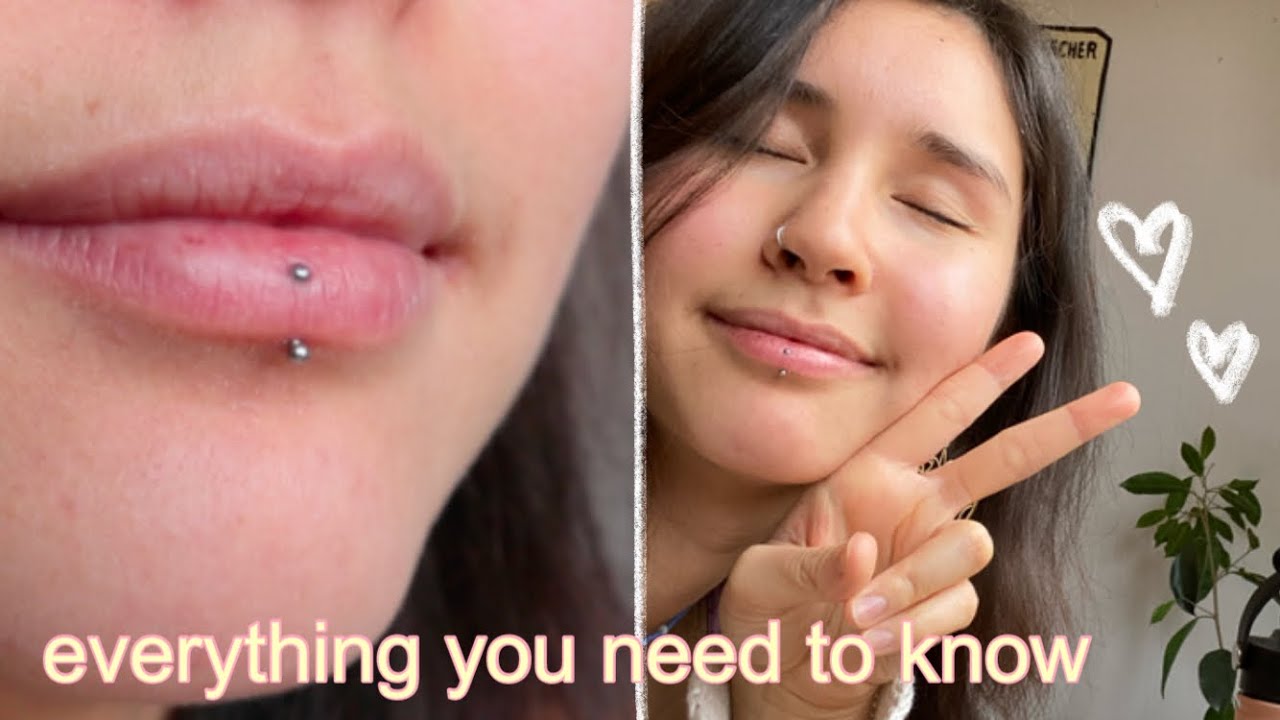Lip piercings have become increasingly popular in the world of body art, offering a unique and bold statement. Whether you're a seasoned pro or a beginner, creating stunning lip piercings is an art that requires precision and creativity. In this comprehensive guide, we will explore the world of lip piercings, from understanding the different types to mastering the art of placement and aftercare. Get ready to unleash your inner artist and design lip piercings like a professional.
Exploring the World of Lip Piercings

Lip piercings come in various styles, each offering a distinct look and personality. Here are some of the most common types of lip piercings to consider:
1. Labret Piercing
The labret piercing is a classic choice, located just below the lower lip. It provides a subtle yet elegant look and is perfect for those who want a versatile piercing.
2. Madonna Piercing
Named after the iconic singer, the Madonna piercing is placed on the upper lip, creating a unique and eye-catching feature. It adds a touch of glamour and can be styled in various ways.
3. Medusa Piercing
Situated in the center of the upper lip, the Medusa piercing is a bold choice. It draws attention to the center of the face and is ideal for those who want a statement-making piercing.
4. Vertical Labret Piercing
This piercing is similar to the labret but with a vertical placement. It adds a unique twist to the traditional labret and can be customized with different jewelry options.
5. Angle Piercing
The angle piercing is a modern take on lip piercings, placed at an angle just below the corner of the mouth. It offers a distinct and trendy look, perfect for those who want to stand out.
6. Dolphin Piercing
For a more unconventional choice, the dolphin piercing is placed on the side of the lip, resembling a dolphin’s fin. It’s a fun and creative option for those seeking a unique piercing experience.
When choosing the type of lip piercing, consider your personal style, face shape, and the overall look you want to achieve. Each piercing has its own character and can be customized further with different jewelry options.
Mastering the Art of Placement

Proper placement is crucial for achieving a beautiful and comfortable lip piercing. Here are some key considerations to keep in mind:
1. Symmetry and Balance
Ensure that the piercing is placed symmetrically, especially if you’re opting for a pair of piercings. Symmetry creates a harmonious look and complements your facial features.
2. Comfort and Functionality
Consider the placement’s comfort and how it will affect your daily activities. Some piercings, like the labret, offer more flexibility and comfort for eating and speaking.
3. Avoid Nerve Paths
Be cautious of piercing over nerve paths, as it can cause discomfort and sensitivity. Consult with an experienced piercer to identify safe and comfortable placement options.
4. Personal Preferences
Ultimately, the placement should align with your personal preferences. Discuss your vision with your piercer to ensure a customized and satisfying result.
Selecting the Right Jewelry

The jewelry you choose for your lip piercing can significantly impact its appearance and comfort. Here are some tips for selecting the perfect jewelry:
1. Material
Opt for high-quality, implant-grade materials like titanium, niobium, or 14k gold. These materials are hypoallergenic and less likely to cause irritation.
2. Style
Choose a style that complements your piercing type and personal style. From simple barbells to more intricate designs, there are endless options to explore.
3. Size and Gauge
Ensure the jewelry’s size and gauge are appropriate for your piercing. Too small or too large jewelry can cause discomfort and affect healing.
4. Customization
Don’t be afraid to customize your jewelry. Many studios offer unique designs or the option to add charms or gemstones, allowing you to create a truly personalized piece.
The Piercing Process

The piercing process is a delicate procedure that should be performed by a trained and licensed professional. Here's a step-by-step guide to what you can expect:
1. Consultation
Schedule a consultation with a reputable piercer to discuss your ideas, preferences, and any concerns you may have. They will guide you through the process and provide expert advice.
2. Marking and Preparation
During the consultation, your piercer will mark the desired placement. They will also sanitize the area and ensure you are comfortable before proceeding.
3. Piercing
Using a sterile needle, your piercer will create the piercing, inserting the jewelry carefully. The process is quick and should be relatively pain-free if done by a skilled professional.
4. Aftercare Instructions
After the piercing, your piercer will provide detailed aftercare instructions. It’s crucial to follow these instructions to ensure proper healing and minimize the risk of infection.
Aftercare for a Healthy Piercing

Proper aftercare is essential for a successful and healthy lip piercing. Follow these guidelines to promote healing and avoid complications:
1. Cleaning Routine
Clean your piercing twice a day with a saline solution or a mild, unscented soap. Gently rinse the area and avoid using harsh chemicals or alcohol-based products.
2. Avoid Touching
Resist the urge to touch or play with your new piercing. This can introduce bacteria and irritate the healing tissue.
3. Oral Hygiene
Maintain good oral hygiene by brushing your teeth regularly and using an antibacterial mouthwash. This helps prevent infection and keeps your mouth clean.
4. Diet and Hydration
Eat a healthy diet and stay hydrated during the healing process. Avoid spicy or acidic foods that may irritate the piercing.
5. Avoid Smoking and Alcohol
Smoking and alcohol consumption can delay healing and increase the risk of infection. It’s best to avoid these habits during the healing period.
6. Professional Check-Ups
Schedule follow-up appointments with your piercer to ensure the piercing is healing properly. They can provide guidance and address any concerns you may have.
Common Concerns and Solutions

While lip piercings are generally safe, some common concerns may arise during the healing process. Here's how to address them:
1. Swelling and Discomfort
Mild swelling and discomfort are normal during the initial healing phase. Apply a cold compress and take over-the-counter pain relievers as needed. Avoid extreme temperatures and spicy foods to minimize irritation.
2. Scabbing and Crusting
It’s common for piercings to develop a crusty layer as they heal. Gently clean the area with a saline solution to remove the crust and promote healing.
3. Infection
Infection is a rare but serious concern. Look out for signs like redness, excessive swelling, pus, or a fever. If you suspect an infection, seek medical attention immediately.
4. Jewelry Snags
Be cautious of your jewelry catching on clothing or other objects. This can cause irritation and prolong the healing process. Consider wearing longer chains or opting for jewelry with a flat back to minimize snags.
Embracing the Art of Lip Piercings

Lip piercings offer a unique form of self-expression, allowing you to showcase your personality and style. By understanding the different types, mastering placement, and following proper aftercare, you can create stunning lip piercings that turn heads and inspire creativity. Remember, the journey to a beautiful piercing begins with a skilled piercer and a commitment to self-care.
💡 Note: Always consult with a licensed professional piercer for expert advice and guidance. They can provide personalized recommendations based on your unique needs and preferences.
How long does it take for a lip piercing to heal?
+The healing time for a lip piercing can vary, but it typically takes around 6 to 8 weeks. Proper aftercare and a healthy lifestyle can accelerate the healing process.
Can I kiss with a lip piercing?
+Yes, you can kiss with a lip piercing, but it’s important to wait until the piercing is fully healed to avoid any discomfort or potential infection.
Are lip piercings painful?
+The pain level varies from person to person, but most people describe the sensation as a quick pinch. The aftercare process is often more uncomfortable than the actual piercing.
Can I change the jewelry myself?
+It’s generally recommended to have a professional piercer change your jewelry, especially during the healing process. They can ensure the piercing is clean and the jewelry is inserted correctly.
Are there any age restrictions for lip piercings?
+Age restrictions vary by location and studio. It’s important to check with your local regulations and consult with a reputable piercer to ensure you meet the age requirements.